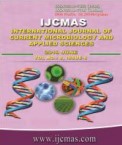


 National Academy of Agricultural Sciences (NAAS)
National Academy of Agricultural Sciences (NAAS)

|
PRINT ISSN : 2319-7692
Online ISSN : 2319-7706 Issues : 12 per year Publisher : Excellent Publishers Email : editorijcmas@gmail.com / submit@ijcmas.com Editor-in-chief: Dr.M.Prakash Index Copernicus ICV 2018: 95.39 NAAS RATING 2020: 5.38 |
Uttar Pradesh is one of the fastest developing states of India. Income of the household is one of the important factors affecting consumption of both the food and non-food products. The gap between the rich and the poor in terms of wealth and incomes is huge. Inequality is also very wide in consumption of luxury goods as well as food commodities in Uttar Pradesh. Food Consumption is an important activity performed by the household sectors. Analysis of inequality in food consumption is one of the major successes of economics as it is essential for a wide range of development policies like sectoral food subsidy, policies related to food production, distribution and macroeconomic policy analysis. This paper revealed striking difference in food consumption pattern of households across income groups and rural and urban sectors in Uttar Pradesh. Analysis of food consumption, using consumption expenditure survey conducted by NSSO, revealed a structural shift towards high value agricultural commodities like milk, fruits, vegetables and non-vegetarian products in the state. High disparity among income groups and rural-urban disparities in Monthly per capita expenditure were observed. The analysis showed that while necessities represent a majority of the consumption basket for very poor and poor income classes, consumption of rich classes was influenced towards milk and fruits. Rich households were found to spend more on non-food items and poor households spend more on food items. This effect was more pronounced for rural area as compared to urban area. Thus key findings were conformity with Engel’s law. The structural shift and diversification of food basket has definite implications on livelihood security and welfare of the households in state Uttar Pradesh.
 |
 |
 |
 |
 |